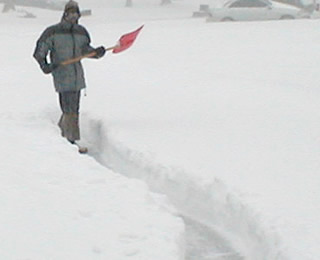 Go to main content
Go to main content
Archive Website of the UK government
Please note that this website has a UK government accesskeys system.
Main menu
Page menu
Newsroom

Clearing snow and ice from pavements yourself
Anyone can clear snow and ice from the pavement outside their home or public spaces to prevent slips and falls. Follow the snow code to clear snow and ice safely.
The snow code - tips on clearing snow and ice from pavements or public spaces

Don’t be put off clearing paths because you’re afraid someone will get injured. Remember, people walking on snow and ice have a responsibility to be careful themselves.
Follow the advice below to make sure you clear the pathway safely and effectively.
And don’t believe the myths - it's unlikely you'll be sued or held legally responsible for any injuries if you have cleared the path carefully.
Clear the snow and ice early in the day
It’s easier to move fresh, loose snow rather than hard snow that has packed together from people walking on it. So if possible, start removing the snow and ice in the morning. If you remove the top layer of snow in the morning, any sunshine during the day will help melt any ice beneath. You can then cover the path with salt before nightfall to stop it refreezing overnight.
Preventing slips

Pay extra attention to clearing snow and ice from steps and steep pathways - you might need to use more salt on these areas
Use salt or sand - not water
Don’t make the pathways more dangerous by causing them to refreeze. If you use water to melt the snow, it may refreeze and turn to black ice. Black ice increases the risk of injuries as it is invisible and very slippery.
You can melt snow or prevent black ice by spreading some salt on the area you have cleared. You can use ordinary table or dishwasher salt - a tablespoon for each square metre you clear should work. Don’t use the salt found in salting bins - this will be needed to keep the roads clear.
Be careful not to spread salt on plants or grass as it may damage them.
If you don’t have enough salt, you can also use sand or ash. These won’t stop the path icing over as effectively as salt, but will provide good grip underfoot.
Take care where you move the snow
When you’re shovelling snow, take care where you put it so it doesn’t block people’s paths or drains. Make sure you make a path down the middle of the area to be cleared first, so you have a clear surface to walk on. Then shovel the snow from the centre of the path to the sides.
Offer to clear your neighbours’ paths
If your neighbour will have difficulty getting in and out of their home, offer to clear snow and ice around their property as well. Check that any elderly or disabled neighbours are alright in the cold weather. If you’re worried about them, try contacting their relatives or friends, or if necessary the local council.
Further information on preparing for winter
Visit the 'Get ready for winter' page. You can find information and suggestions there of simple things you can do to help keep you and your family warm, healthy and safe through the cold weather.
Winter services from your local council
Your local council will provide many winter services such as clearing local roads and pavements in your area. For information about your council’s winter service, check its website.
 Facebook
Facebook Twitter
Twitter StumbleUpon
StumbleUpon Delicious
Delicious Reddit
Reddit
